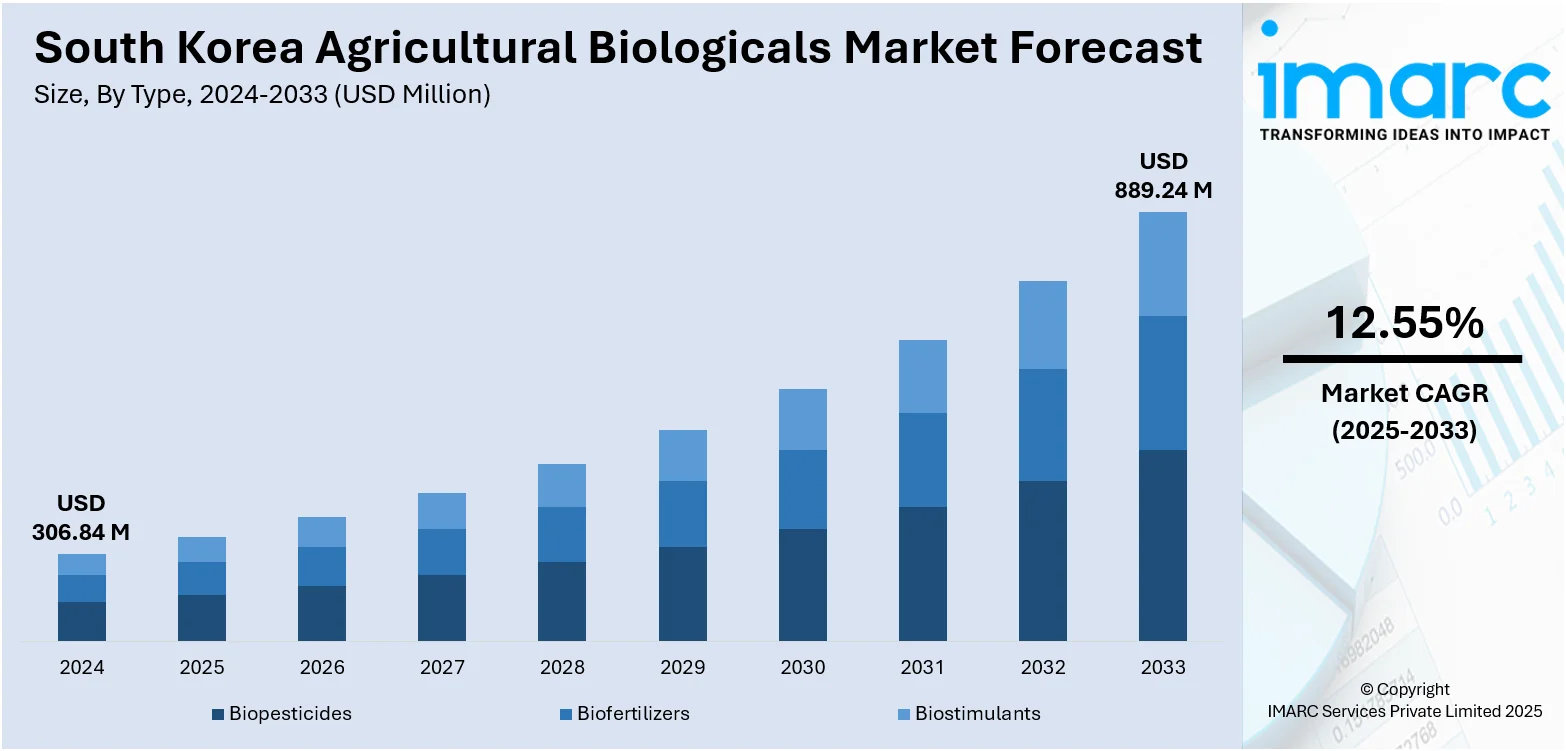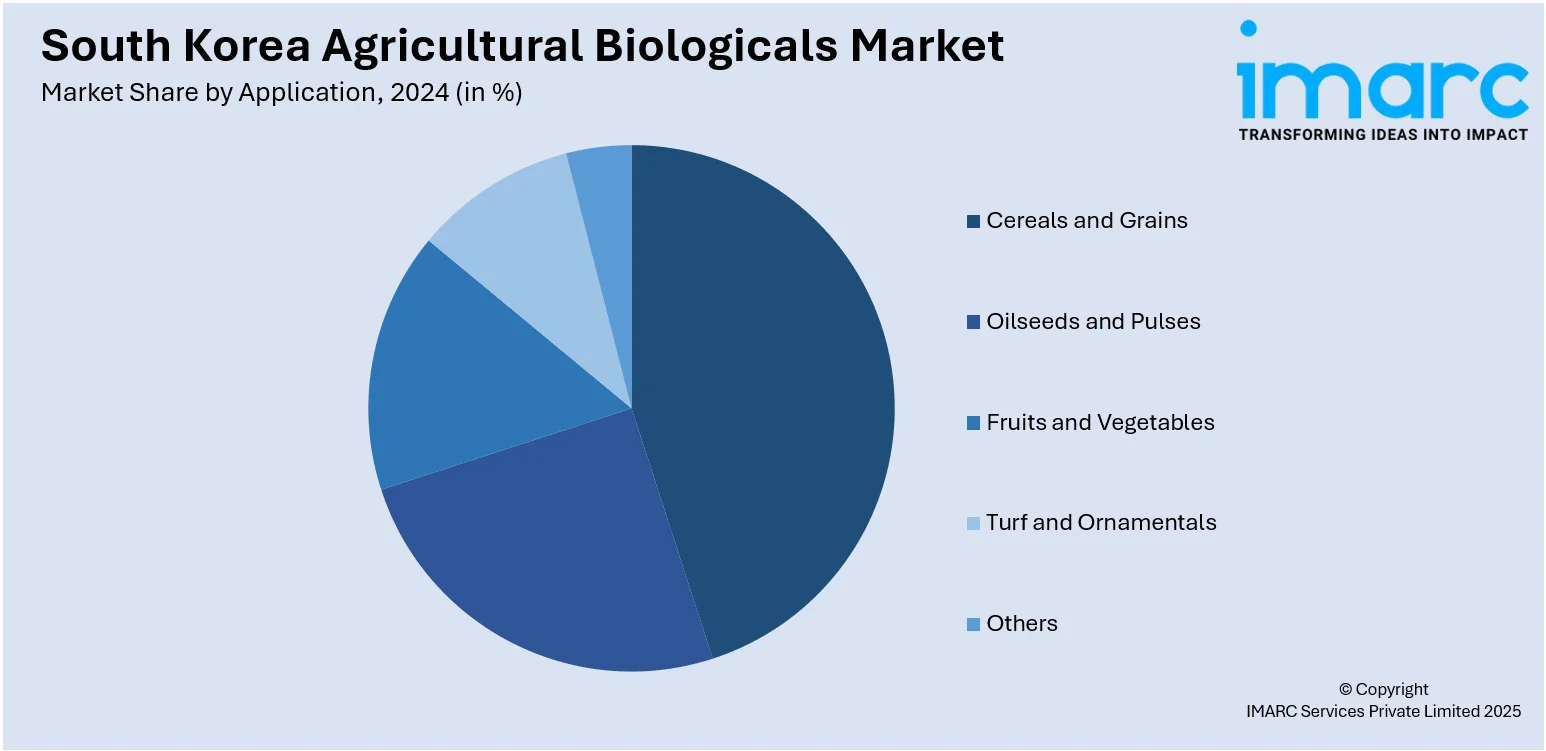
South Korea Agricultural Biologicals Market Size, Share, Trends and Forecast by Type, Source, Mode of Application, Application, and Region, 2025-2033
South Korea Agricultural Biologicals Market Overview:
The South Korea agricultural biologicals market size reached USD 306.84 Million in 2024. Looking forward, IMARC Group expects the market to reach USD 889.24 Million by 2033, exhibiting a growth rate (CAGR) of 12.55% during 2025-2033. The market is witnessing steady growth, driven by rising demand for eco-friendly farming solutions and reduced dependence on synthetic agrochemicals. Increasing consumer awareness regarding organic produce and government support for sustainable agriculture are further propelling the market. These factors collectively contribute to the expanding South Korea agricultural biologicals market share.
|
Report Attribute
|
Key Statistics
|
|---|---|
|
Base Year
|
2024
|
|
Forecast Years
|
2025-2033
|
|
Historical Years
|
2019-2024
|
| Market Size in 2024 | USD 306.84 Million |
| Market Forecast in 2033 | USD 889.24 Million |
| Market Growth Rate 2025-2033 | 12.55% |
South Korea Agricultural Biologicals Market Trends:
Government Support and Subsidies
Government initiatives are essential in promoting sustainable farming practices in South Korea. By offering targeted subsidies, grants, and educational resources, the government encourages eco-friendly agriculture, which encompasses the use of biological crop protection and nutrition solutions. These policies are designed to lessen the nation’s reliance on chemical pesticides and fertilizers, leading to improved soil health and safer food production. To facilitate this transition, farmers receive financial support and training programs that highlight the long-term advantages of using biopesticides and biofertilizers. Additionally, government-supported research institutions are working with local manufacturers to foster innovation in this sector. These supportive actions are greatly contributing to South Korea agricultural biologics market growth, making it a vital component of the country's larger agricultural sustainability objectives.

To get more information on this market, Request Sample
Rising Demand for Organic Farming
The growing preference among consumers for food that is free from chemicals and produced sustainably is a significant driver behind the rise of biological products in the agricultural sector of South Korea. With an increase in health awareness, there is a heightened demand for organic fruits, vegetables, and grains, prompting farmers to reduce their use of synthetic chemicals. This transition has resulted in a notable increase in the application of agricultural biologicals, including biopesticides, biofungicides, and biofertilizers. For instance, in May 2025, the Research Institute of Organic Agriculture (FiBL) and South Korea's National Institute of Agricultural Sciences (NAS) extended their collaboration through a new Memorandum of Understanding. This partnership aims to enhance organic farming methods tailored to local conditions, focusing on smart farming and climate farming practices. These products not only comply with organic certification requirements but also enhance soil health and crop durability. Retailers and food companies are backing this movement by sourcing organic produce, which reinforces the demand within the supply chain. Consequently, the need for biological solutions is emerging as a major factor in the growth of the agricultural biologics market in South Korea.
Technological Advancements
Innovation is crucial in the evolution of the agricultural biologics market in South Korea. There has been significant progress in developing microbial-based formulations that are now more precise, stable, and effective across different climatic conditions. Researchers and biotechnology companies are consistently improving the effectiveness and shelf life of products like biofertilizers and biopesticides through advancements in encapsulation techniques, fermentation processes, and strain optimization. These improvements enable biologicals to deliver consistent results, making them an attractive option for contemporary farmers who are accustomed to the reliability of chemical alternatives. Additionally, advancements in delivery methods such as foliar sprays, seed coatings, and solutions compatible with drip irrigation are increasing user-friendliness. As these technologies advance, they contribute to closing the gap between traditional farming methods and modern sustainable agriculture, thereby accelerating market growth.
South Korea Agricultural Biologicals Market Segmentation:
IMARC Group provides an analysis of the key trends in each segment of the market, along with forecasts at the country and regional levels for 2025-2033. Our report has categorized the market based on type, source, mode of application, and application.
Type Insights:
- Biopesticides
- Biofertilizers
- Biostimulants
The report has provided a detailed breakup and analysis of the market based on the type. This includes biopesticides, biofertilizers, and biostimulants.
Source Insights:
- Microbials
- Macrobials
- Biochemicals
- Others
A detailed breakup and analysis of the market based on the source have also been provided in the report. This includes microbials, macrobials, biochemicals, and others.
Mode of Application Insights:
- Foliar Spray
- Soil Treatment
- Seed Treatment
- Post-Harvest
A detailed breakup and analysis of the market based on the mode of application have also been provided in the report. This includes foliar spray, soil treatment, seed treatment, and post-harvest.
Application Insights:

- Cereals and Grains
- Oilseed and Pulses
- Fruits and Vegetables
- Turf and Ornamentals
- Others
A detailed breakup and analysis of the market based on the application have also been provided in the report. This includes cereals and grains, oilseed and pulses, fruits and vegetables, turf and ornamentals, and others.
Regional Insights:
- Seoul Capital Area
- Yeongnam (Southeastern Region)
- Honam (Southwestern Region)
- Hoseo (Central Region)
- Others
The report has also provided a comprehensive analysis of all the major regional markets, which include Seoul Capital Area, Yeongnam (Southeastern Region), Honam (Southwestern Region), Hoseo (Central Region), and others.
Competitive Landscape:
The market research report has also provided a comprehensive analysis of the competitive landscape. Competitive analysis such as market structure, key player positioning, top winning strategies, competitive dashboard, and company evaluation quadrant has been covered in the report. Also, detailed profiles of all major companies have been provided.
South Korea Agricultural Biologicals Market Report Coverage:
| Report Features | Details |
|---|---|
| Base Year of the Analysis | 2024 |
| Historical Period | 2019-2024 |
| Forecast Period | 2025-2033 |
| Units | Million USD |
| Scope of the Report |
Exploration of Historical Trends and Market Outlook, Industry Catalysts and Challenges, Segment-Wise Historical and Future Market Assessment:
|
| Types Covered | Biopesticides, Biofertilizers, Biostimulants |
| Sources Covered | Microbials, Macrobials, Biochemicals, Others |
| Mode of Applications Covered | Foliar Spray, Soil Treatment, Seed Treatment, Post-Harvest |
| Applications Covered | Cereals and Grains, Oilseed and Pulses, Fruits and Vegetables, Turf and Ornamentals, Others |
| Regions Covered | Seoul Capital Area, Yeongnam (Southeastern Region), Honam (Southwestern Region), Hoseo (Central Region), Others |
| Customization Scope | 10% Free Customization |
| Post-Sale Analyst Support | 10-12 Weeks |
| Delivery Format | PDF and Excel through Email (We can also provide the editable version of the report in PPT/Word format on special request) |
Key Questions Answered in This Report:
- How has the South Korea agricultural biologicals market performed so far and how will it perform in the coming years?
- What is the breakup of the South Korea agricultural biologicals market on the basis of type?
- What is the breakup of the South Korea agricultural biologicals market on the basis of source?
- What is the breakup of the South Korea agricultural biologicals market on the basis of mode of application?
- What is the breakup of the South Korea agricultural biologicals market on the basis of application?
- What is the breakup of the South Korea agricultural biologicals market on the basis of region?
- What are the various stages in the value chain of the South Korea agricultural biologicals market?
- What are the key driving factors and challenges in the South Korea agricultural biologicals market?
- What is the structure of the South Korea agricultural biologicals market and who are the key players?
- What is the degree of competition in the South Korea agricultural biologicals market?
Key Benefits for Stakeholders:
- IMARC’s industry report offers a comprehensive quantitative analysis of various market segments, historical and current market trends, market forecasts, and dynamics of the South Korea agricultural biologicals market from 2019-2033.
- The research report provides the latest information on the market drivers, challenges, and opportunities in the South Korea agricultural biologicals market.
- Porter's five forces analysis assist stakeholders in assessing the impact of new entrants, competitive rivalry, supplier power, buyer power, and the threat of substitution. It helps stakeholders to analyze the level of competition within the South Korea agricultural biologicals industry and its attractiveness.
- Competitive landscape allows stakeholders to understand their competitive environment and provides an insight into the current positions of key players in the market.
Need more help?
- Speak to our experienced analysts for insights on the current market scenarios.
- Include additional segments and countries to customize the report as per your requirement.
- Gain an unparalleled competitive advantage in your domain by understanding how to utilize the report and positively impacting your operations and revenue.
- For further assistance, please connect with our analysts.
 Request Customization
Request Customization
 Speak to an Analyst
Speak to an Analyst
 Request Brochure
Request Brochure
 Inquire Before Buying
Inquire Before Buying




.webp)




.webp)












